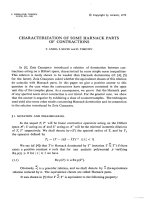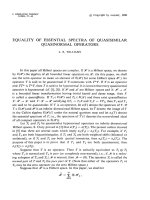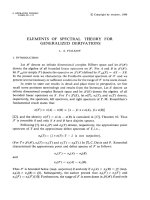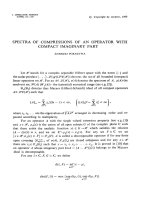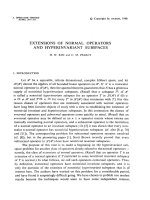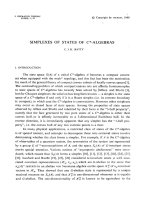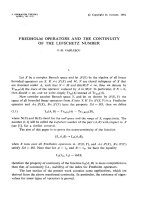Báo cáo toán học: "Sets of integers that do not contain long arithmetic progression" pot
Bạn đang xem bản rút gọn của tài liệu. Xem và tải ngay bản đầy đủ của tài liệu tại đây (192.86 KB, 15 trang )
Sets of integers that do not contain
long arithmetic progressions
Kevin O’Bryant
∗
Department of Mathematics
The City University of New York
College of Staten Island and The Graduate Center
Submitted: Feb 1, 2011; Accepted: Mar 2, 2010; Published: Mar 11, 2011
Mathematics S ubject Classification: 11B25
Abstract
Combining ideas of Rankin, Elkin, Green & Wolf, we give constructive lower
bounds for r
k
(N), the largest size of a subset of {1, 2, . . . , N } that d oes not contain
a k -element arithmetic progression: For every ǫ > 0, if N is sufficiently large, then
r
3
(N) ≥ N
6 · 2
3/4
√
5
e π
3/2
−ǫ
exp
−
8 log N +
1
4
log log N
,
r
k
(N) ≥ N C
k
exp
−n2
(n−1)/2
n
log N +
1
2n
log log N
,
where C
k
> 0 is an unspecified constant, log = log
2
, exp(x) = 2
x
, and n = ⌈log k⌉.
These are currently the best lower bounds for all k, and are an improvement over
previous lower b ounds for all k = 4.
We denote by r
k
(N) the maximum possible size of a subset of {1, 2, . . . , N} that does
not contain k numbers in arithmetic progression. Behrend [1] proved that
r
3
(N)
N
≥ C exp
−(1 + ǫ)
8 log N
,
where exp and log are the base-2 exponential and logarithm and each occurrence of C is
a new positive constant. Sixty years later, Elkin [2] introduced a new idea to Behrend’s
work and showed that there are arbitrarily large N satisfying
r
3
(N)
N
≥ C exp
−
8 log N +
1
4
log log N
,
∗
This work was supported by a grant from The City University of New Yor k PSC-CUNY Resear ch
Award Program.
the electronic journal of combinatorics 18 (2011), #P59 1
and shortly afterwards Green & Wolf [6] arrived at the same bound by a different method.
For k ≥ 1 + 2
n−1
, Rankin [10] proved that for each ǫ > 0, if N is sufficiently large then
r
k
(N)
N
≥ C exp
−n 2
(n−1)/2
(1 + ǫ)
n
log N
,
where n = ⌈log k⌉. For k = 3, Rankin’s construction is the same as that of Behrend. This
was subsequently rediscovered in a simpler, but less precise, form by Laba & Lacey [8].
Together with the obvious r
k
(N) ≤ r
k+1
(N), r
k
(N + M) ≤ r
k
(N) + r
k
(M), these were the
thickest known constructions. The primary interest in the current work is the following
corollary of our main theorem.
Corollary 1. Fix k, and set n = ⌈log k⌉. There exists a positive constant C such that
for all N ≥ 1
r
k
(N)
N
≥ C exp
−n2
(n−1)/2
n
log N +
1
2n
log log N
For every ǫ > 0, if N is sufficiently large then
r
3
(N)
N
≥
6 · 2
3/4
√
5
e π
3/2
−ǫ
exp
−
8 log N +
1
4
log log N
.
The constant in the r
3
bound is around 1.5, so we have the pleasant-to-write conse-
quence:
r
3
(N) ≥ N exp
−
8 log N +
1
4
log log N
≥ N 2
−
√
8 log N
for sufficiently large N.
Szemer´edi’s Theorem states that r
k
(N) = o(N), and the task of getting better upper
bounds on r
k
(N) has been mathematically fruitful. The currently-best upper bounds on
r
k
(N) (for sufficiently large N) are due to Sanders [11], Green & Tao [5], and Gowers [4],
respectively, and are shown here with our lower bounds:
−
8 log N +
1
4
log log N + 1 ≤ log
r
3
(N)
N
≤ −log log N + 5 log log log N + C;
−
8 log N +
1
4
log log N + 1 ≤ log
r
4
(N)
N
≤ −C
log log N;
−n2
(n−1)/2
n
log N +
1
2n
log log N + C ≤ log
r
k
(N)
N
≤ −2
−2
k+9
log log log N.
It is naturally tempting to speculate as to whether the upper or lower bound on r
k
(N)
is closer to the truth. Certainly, the upper bounds have seen a steady stream of substantive
improvements, while the main term of the lower bound has remained unchanged for more
than a half century. The reader is directed to a discussion on Gil Kalai’s blog [7] for some
relevant speculative remarks of Gowers and of Kalai’s.
To prove our result we need to induct through sets that do not contain more elaborate
types of progressions. A k-term D-progression is a sequence of the form
Q(1), Q(2), . . . , Q(k)
the electronic journal of combinatorics 18 (2011), #P59 2
where Q is a nonconstant polynomial with degree at most D. For example, 1-progressions
are proper arithmetic progressions. The sequences 2, 1, 2, 5, 10 and 1, 2, 4, 7, 11 are 5-term
2-progressions arising from the polynomials (j −2)
2
+ 1 and (j
2
−j + 2)/ 2. In particular,
a progression of integers may contain the same number in different places, and may arise
from a polynomial whose coefficients are not integers. Also, note that the class of k-
term D-progressions is invariant under both translation and dilation. Let r
k,D
(N) denote
the maximum possible size of a subset of [1, N] ∩ Z that does not contain any k-term
D-progressions.
Theorem 1. Fix positive integers k, D and set n = ⌈log(k/D)⌉. There exists a positive
constant C such that for every N
r
k,D
(N)
N
≥ C exp
−n2
(n−1)/2
D
(n−1)/n
n
log N +
1
2n
log log N
.
To explain what is new and interesting in the current work, we begin by summarizing
the earlier constructions. Behrend’s construction [1], while no longer the numerically
best or most general, remains the most elegant. His initial observation is that a sphere
cannot contain a 3-term arithmetic progression simply because a line and a sphere cannot
intersect more than twice. Let S be a set of points in Z
d
all lying on one sphere and
having all coordinates positive and smaller than P , and then let A be the image of S
under the map ϕ : x
1
, . . . , x
d
→
d
i=1
x
i
(2P )
i−1
. Because 0 < x
i
< P , addition of two
elements of A will not involve any carrying. This ϕ is therefore a Freiman 2-isomorphism
between S and A; that is, x
1
+ x
2
= x
3
+ x
4
if and only if ϕ(x
1
) + ϕ(x
2
) = ϕ(x
3
) + ϕ(x
4
).
Since three integers a < b < c are in arithmetic progression if and only if a + c = b + b,
this proves that A is free of 3-term arithmetic progressions. The only remaining work
is to show that there exists a suitably large S, which Behrend did with the pigeonhole
principle, and to optimize P and d in terms of N.
Rankin combined three observations. His first observation was that Behrend’s use of
the pigeonhole principle could be replaced with a number-theoretic result on the number
of representations of a huge number as a sum of a large number of squares. The second
is that a degree D polynomial cannot intersect a sphere in more than 2D points, and
so Behrend’s argument actually gives a lower bound on r
2D+1,D
. The third is that one
can use a set that does not contain k-term 2D-progressions to build S as a union of
concentric spheres with skillfully chosen radii. The corresponding set A (after mapping S
as per Behrend, but with the radix 2P replaced by something much larger) will necessarily
be free of k-term D-progressions. This provided for an inductive bound. For example,
r
9
= r
9,1
is bounded in terms of r
9,2
, which is bounded in terms of r
9,4
, which is then
bounded using Rankin’s generalized Behrend argument.
Elkin [2] improved Behrend’s 3-term construction in two ways. First, he used the
central limit theorem (and the pigeonhole principle) to guarantee the existence of a large
S; and second, he considered lattice points in a very thin annulus. Using an annulus
instead of a sphere leads to a set S that is substantively larger but, unfortunately, does
have 3-term arithmetic progressions. After removing a small number of points to eliminate
the electronic journal of combinatorics 18 (2011), #P59 3
the progressions, Elkin proceeded along the same line as Behrend, needing to optimize d,
P , and also the thickness of the annulus.
Green & Wolf [6] give an argument that spiritually similar to Elkin’s, but avoids
counting lattice points. In the d-dimensional torus, they take S to be the intersection of
a small box and an annulus. Using random elements ω, α of the torus, they consider the
map ϕ : n → n ω + α. Letting A := {a: ϕ(a) ∈ S}, this map is a Freiman 2-isomorphism
between A and ϕ(A). The randomness allowed them to easily count the size of A and the
number of progressions in A that need to be removed.
In the current work we recast Rankin’s ideas using the lessons of Elkin and Green &
Wolf. We avoid Rankin’s sum-of-squares number theory lemma by taking random ω, α
(unfortunately, we still need the pigeonhole principle). We find the right generalization
of “an arithmetic progression in a thin annulus has a small difference” to D -progressions,
and thereby generalize Elkin’s result to improve Rankin’s bound on r
2D+1,D
. Finally,
by taking concentric annuli, we smooth out Rankin’s inductive step. We note also that
previous work has sometimes suffered
1
from a cavalier treatment of error terms. For
example, Elkin’s “arbitrarily large N” and Rankin’s “1 + ǫ” term can be eliminated with
a little care. We have taken the opposite tack here, in places working for coefficients
that are not important in the final analysis, but which we consider to be of interest. In
particular, the refinement for r
3
stated in Corollary 1 constitutes about 15% (by volume)
of this work.
1 Notation
Throughout, log and exp refer to the base-2 logarithm and exponential. Vectors are all
given overlines, as in x, and all have dimension d.
The parameters N and d tend to infinity together, with N much larger than d, and
all little-oh notation is with respect to N and d. The parameter d is a dimension, and
must be an integer, while N need not be an integer. The other fundamental parameters,
the integers k and D, are held constant.
We define the difference operator ∆ to be the map taking a finite sequence (a
i
)
k
i=1
to
the finite sequence (a
v+1
− a
v
)
k−1
v=1
. The formula for repeated differencing is then
∆
n
(a
i
) =
n
i=0
n
i
(−1)
i
a
i+v
k−n
v=1
.
We note that a nonconstant sequence (a
i
) with at least D + 1 terms is a D-progression if
and only if ∆
D+1
(a
i
) is a sequence of zeros. If a
i
= p(i), with p a polynomial with degree
D and lead term p
D
, then ∆
D
(a
i
) = (D!p
D
), a constant sequence. Note also that ∆ is a
linear operator. Finally, we will make repeated use of the fact, provable by induction for
1 ≤ n ≤ k, that
|∆
n
(a
i
)| ≤ 2
n−1
max
i
a
i
− min
i
a
i
.
1
Some would say benefitted.
the electronic journal of combinatorics 18 (2011), #P59 4
A k-term type-(n, a, b) progression is a nonconstant sequence a
1
, a
2
, . . . , a
k
with k ≥ n,
a
1
= a, and n-th differences ∆
n
(a
i
) the constant nonzero sequence (b). For example, if p
is a degree n polynomial (with lead term p
n
= 0) and k ≥ n, then p(1), . . . , p(k) is a type
(n, p(1), n!p
n
) progression.
The open interval (a−b, a+ b) of real numbers is denoted a±b. The interval [1, N]∩Z
of natural numbers is denoted [N]. For positive integers i, the box (0 ± 2
−i−1
)
d
, which
has Lebesgue measure 2
−id
, is denoted Box
i
. We define Box
0
= [−1/2, 1/2)
d
, and define
x mod 1 to be the unique element y of Box
0
with x −y ∈ Z
d
.
A point x = X
1
, . . . , X
d
chosen uniformly from Box
D
has components X
i
indepen-
dent and uniformly distributed in (−2
−D−1
, 2
−D−1
). Therefore, x
2
2
=
d
i=1
X
2
i
is the
sum of d iidrvs, and is therefore normally distributed as d → ∞. Further x
2
2
has mean
µ
D
:= 2
−2D
d/12 and variance σ
2
D
:= 2
−4D
d/180.
For any set A ⊆ [n], positive integer D, and sufficiently small positive real number δ,
we define Annuli(A, n, D, δ) in the following manner:
Annuli(A, n, D, δ) :=
x ∈ Box
D
:
x
2
2
− µ
D
σ
D
∈
a∈A
z −
a − 1
n
± δ
,
where z ∈ µ
D
± σ
D
is chosen to maximize the volume of Annuli(A, n, D, δ). Geometri-
cally, Annuli(A, n, D, δ) is the union of |A| spherical shells, intersected with Box
D
.
2 Lemmas
The following lemma is best-possible for k = 2D + 1. Improving the bound for larger k
comes down to the following problem: if Q has degree D and all of |Q(1)|, . . . , |Q(k)| are
less than 1, then how big can the leading coefficient of Q be? This lemma plays the role
that “a line intersects a sphere in at most two points” played for Behrend, and that “a
degree D polynomial curve intersects a sphere in at most 2D points” played for Rankin.
Green & Wolf handle the D = 1 case by a simple geometric argument.
Lemma 1 (Sphere-ish polynomials have small-ish lead coefficients). Let δ, r be real num-
bers with 0 ≤ δ ≤ r, and let k, D be integers with D ≥ 1, k ≥ 2D + 1. If P (j) is
a polynomial with degree D, and r − δ ≤ P (j)
2
2
≤ r + δ for j ∈ [k], then the lead
coe ffi c i ent of P has norm at most 2
D
(2D)!
−1/2
√
δ.
Proof. In this paragraph we summarize the proof; in subsequent paragraphs we provide
the details. Q(j) := P (j)
2
2
− r is a degree 2D polynomial of j, and each of the 2D + 1
real numbers Q(1), . . . , Q(2D + 1) are close to zero. If they were all exactly zero, then Q
would have more zeros than its degree and so would necessarily be identically zero. Just
having that many values close to 0, however, is already enough to guarantee that the lead
coefficient of Q is small.
Let P (j) = P
0
+ P
1
j + ··· + P
D
j
D
. We work with the degree 2D polynomial
Q(j) := P (j)
2
2
− r =
2D
n=0
q
n
j
n
,
the electronic journal of combinatorics 18 (2011), #P59 5
and note in particular that q
2D
= P
D
2
2
. As 0 ≤ δ ≤ r, we conclude that |Q(j)| ≤ δ.
Set q, Q to be the column vectors q
0
, q
1
, . . . , q
2D
T
, Q(1), . . . , Q(2D + 1)
T
, respec-
tively. Let M be the (2D + 1) ×(2D + 1) matrix whose (i, j)-component is i
j−1
. We have
the system of equations
M q = Q,
which is nonsingular because M is a Vandermonde matrix. By Cramer’s rule, the cofactor
expansion of a determinant along the last column, and the triangle inequality,
q
2D
=
det(M
′
)
det(M)
=
1
det(M)
2D+1
j=1
Q(j)(−1)
j+1
M
j,2D+1
≤
2D+1
j=1
|M
j,2D+1
|
|det(M)|
δ.
By the formula for the determinant of a Vandermonde matrix (the relevant minors of M
are also Vandermonde matrices), we find that
P
D
2
2
= q
2D
≤
2D+1
j=1
|M
j,2D+1
|
|det(M)|
δ =
2
2D
(2D)!
δ,
completing the proof.
The next lemma plays the role that “integers whose base-2b + 1 expansions only use
the digits {0, 1, . . . , b} can be added without carrying” played for Behrend, and that
“a polynomial with degree D can be evaluated at integers whose base-B(b) expansions
only use the digits {0, 1, . . . , b} without carrying, provided that B(b) is sufficiently large”
played for Rankin. The D = 1 case is directly in the work of Green & Wolf.
Lemma 2 (Tight modular progressions are also non-modular progressions). Suppose that
p(j) is a polynomial with degree D, with D-th coefficien t p
D
, and set x
j
:= ω p (j) + α
mod 1. If x
1
, x
2
, . . . , x
k
are in Box
D
and k ≥ D + 2, then there is a vector polynomial
P (j) =
D
i=0
P
i
j
i
with P (j) = x
j
for j ∈ [k], and D!P
D
= ω D!p
D
mod 1.
Proof. Since p has degree D, the (D + 1)-th differences of p(1), p(2), . . . , p(k) are zero,
and therefore the (D + 1)-th differences of x
1
, x
2
, . . . , x
k
are 0 modulo 1, i.e., all of their
components are integers. We will show that in fact all of their components are strictly
between −1 and 1, and so they must all be 0.
The (D + 1)-th differences are given by (valid only for 1 ≤ v ≤ k −D −1)
∆
D+1
(x
i
)(v) =
D+1
i=0
D + 1
i
(−1)
i
x
v+i
.
Denote the i-th component of x
j
by x
(i)
j
. As x
v+i
∈ Box
D
, each component of x
v+i
is in
−2
−D−1
, 2
−D−1
. Thus, the h-th component of ∆
D+1
(x
i
)(v) satisfies
D+1
i=0
D + 1
i
(−1)
i
x
(h)
v+i
≤
D+1
i=0
D + 1
i
|x
(h)
v+i
| <
D+1
i=0
D + 1
i
2
−(D+1)
= 1,
the electronic journal of combinatorics 18 (2011), #P59 6
and therefore ∆
D+1
(x
i
) = (0).
Now,
D!P
D
= ∆
D
(P (i)) = ∆
D
(x
i
) ≡ ωD!p
D
(mod 1).
As P (i) ∈ Box
D
for 1 ≤ i ≤ k, the above binomial-coefficient triangle-inequality ar-
gument tells us that the components of ∆
D
(P (i)) are between −1/2 and 1/2, and so
D!P
D
=
ωD!p
D
mod 1
.
Behrend and Rankin needed to find spheres that contain many lattice points, which is
a fundamentally number theoretic issue that they handled with the pigeonhole principle
and the circle method, respectively. Here, as in Green & Wolf, we don’t need lattice
points on spheres but to put a dynamical system in an annulus frequently; this is merely
a measure theoretic/geometric issue.
Lemma 3 (Annuli has large volume). If d is sufficiently large, A ⊆ [n], and 2δ ≤ 1/n,
then the volume of Annuli(A, n, D, δ) is at least
2
5
2
−dD
|A|δ. Provided that δ log d → 0,
the vol ume of Annuli({1}, 1, D, δ) is at least (
2/π −o(1)) 2
−dD
δ.
Proof. A uniformly chosen element x = X
1
, . . . , X
d
of Box
D
has the X
i
independent
and each uniformly distributed in (−2
−D−1
, 2
−D−1
). Thus x
2
2
is the sum of d iidrvs and
has mean µ
D
:= 2
−2D
d/12 and variance σ
2
D
:= 2
−4D
d/180. By the central limit theorem
(CLT), the random variable
x
2
2
− µ
D
σ
D
has a normal distribution, as d → ∞, with mean 0 and variance 1. We would like to
argue that
vol Annuli({1}, 1, D, δ) ≥ 2
−dD
δ
−δ
e
−x
2
/2
√
2π
dx
≥ 2
−dD
2δ
e
−δ
2
/2
√
2π
= 2
−dD
δ
2/π −o(1)
,
but we cannot apply the CLT to an interval that is shrinking as rapidly as ±δ. We get
around this by applying the CLT to an interval that shrinks very slowly, and then using an
analytic form of the pigeonhole principle to guarantee an appropriately short subinterval
with the needed density.
We could accomplish this using only the classical CLT, but it is expeditious to use
the quantitative CLT known as the Berry-Esseen theorem [3, Section XVI.5], which is
applicable since
ρ
D
:= E
|X
2
i
−2
−2D
/12|
3
= 2
−6D
(3 + 2
√
3)/11340 < ∞.
Let I be an interval whose endpoints depend on d. The Berry-Esseen theorem implies
that
P
x
2
2
− µ
σ
D
∈ I
≥
1
√
2π
I
exp(−x
2
/2) dx − 2
ρ
D
(σ
D
/
√
d)
3
√
d
.
the electronic journal of combinatorics 18 (2011), #P59 7
First we handle the case A = {1}, n = 1. We have
P
x
2
2
−µ
D
σ
D
∈ ±
1
log d
≥
1
√
2π
1/ log d
−1/ log d
exp(−x
2
/2) dx − 2
ρ
D
(σ
D
/
√
d)
3
√
d
≥
1
√
2π
2
log d
exp
−(1/ log d)
2
/2
−
3
√
d
≥
2/π
log d
1 −
1
2
(log d)
−4
− 3(log d )d
−1/2
≥
2/π
log d
1 − (log d)
−4
.
Let f be the density function of
x
2
2
−µ
D
σ
D
, and let χ
I
be the indicator function of I. Since
the convolution
(fχ
±1/ log d
) ∗ χ
±δ
is supported on ±(1/ log d + δ) and has 1-norm
fχ
±1/ log d
)
1
χ
±δ
1
≥
2/π
log d
1 − (log d)
−4
2δ,
there must be some z with
(fχ
±1/ log d
) ∗ χ
±δ
(z) ≥
√
2/π
log d
(1 − (log d)
−4
)
2δ
2/ log d + 2δ
= δ
2
π
1 − (log d)
−4
1 + δ log d
=
2/π −o(1)
δ.
Consequently, vol Annuli({1}, 1, D, δ) ≥
2
π
− o(1)
2
−dD
δ.
Similar calisthenics make the following heuristic argument rigorous. Let G be a normal
rv with mean 0 and variance 1:
vol(Annuli(A, n, D, δ)) → 2
−dD
P
ω ,α
G ∈
a∈A
−
a − 1
n
± δ
≥ 2
−dD
P
ω ,α
G ∈
− 1, −1 + 2δ|A|
= 2
−dD
1
√
2π
−1+2δ|A|
−1
exp(−x
2
/2) dx
≥ 2
−dD
1
√
2π
exp(−1/2)2δ| A|
>
2
5
2
−dD
|A|δ,
the electronic journal of combinatorics 18 (2011), #P59 8
where we have used 2δ ≤ 1/n to force the intervals −(a − 1)/n ± δ to be disjoint, and
also to force −1 + 2δ|A| < 0. Since the final inequality is strict, we can replace the limit
in the central limit theorem with a “sufficiently large d” hypothesis.
We comment that the use of the pigeonhole principle and the CLT in the previous
lemma could be removed. The distribution of X
2
i
is explicit, and so we could, at least
in principle, work out an explicit form for the density of x
2
(similar in spirit to the
Irwin-Hall distribution). This would also likely allow one to take z = 0.
The k = 3, D = 1 case of the following lemma is in Green & Wolf.
Lemma 4 is not best possible. However, the factor 2
D+1
will turn out to be irrelevant
in the final analysis.
Lemma 4 (There are not many types of progressions). Assume k ≥ D. There are fewer
than 2
D+1
N
2
types of k-term progressions with degree at most D contained in [N].
Proof. We suppose that we have a k-term progression a
1
, . . . , a
k
contained in [N] of type
(D
′
, a, b), and find restrictions on D
′
, a and b. First, fix D
′
. There are clearly at most N
possibilities for a. It is straightforward to prove by induction that for ℓ ∈ {1, . . . , D
′
}
−2
ℓ−1
N < ∆
ℓ
(a
i
)(v) < 2
ℓ−1
N.
Since ∆
D
′
(a
i
) must be a nonzero constant sequence of integers, there are fewer than 2
D
′
N
possibilities for the constant sequence (b) = ∆
D
′
(a
i
). Summing this total over 1 ≤ D
′
≤ D
yields the claim.
3 A base case and an inductive step
Following Laba & Lacey (it is implicitly in Rankin), we proceed by induction. The
statements of the next two propositions are extremely similar to what appears in Laba &
Lacey, but the proofs are considerably messier.
Proposition 1 (Base Case). If k > 2D, then as N → ∞
r
k,D
(N)
N
≥
√
90
eπ
3/2
2
D
D
1/4
2D
D
− o(1)
4
√
2 log N
2
√
8D log N
. (1)
Proposition 2 (Inductive Step). I f k > 2D, then there exists a positive constant C
r
k,D
(N)
N
≥ C 2
−dD
r
k,2D
(N
0
)
N
0
,
where
N
0
:=
eπ
3
√
5
4
D
2D
D
−1
N
2/d
d
1/2
.
the electronic journal of combinatorics 18 (2011), #P59 9
Let A
0
be a subset of [N
0
] with cardinality r
k,2D
(N
0
) that does not contain any k-term
2D-progression, assume 2δN
0
≤ 2
−2D
, and let
A := A(ω, α) = {n ∈ [N] : n ω + α mod 1 ∈ Annuli(A
0
, N
0
, D, δ)},
which we will show is typically (with respect to ω, α being chosen uniformly from Box
0
) a
set with many elements and few types of D-progressions. After removing one element from
A for each type of progression it contains, we will be left with a set that has large size and
no k-term D-progressions. Since Box
0
×Box
0
has Lebesgue measure 1, this argument
could be easily recast in terms of Lebesgue integrals, but we prefer the probabilistic
notation and language.
Define T := T (ω, α) to be the set
a ∈ [N]:
∃b ∈ R, D
′
∈ [D] such that A(ω, α) contains
a k-term progression of type (D
′
, a, b)
,
which is contained in A(ω, α). Observe that A \ T is a subset of [N] and contains no
k-term D-progressions, and consequently r
k,D
(N) ≥ |A \T | = |A|−|T | for every ω, α. In
particular,
r
k,D
(N) ≥ E
ω,α
[|A| − |T |] = E
ω,α
[|A|] − E
ω,α
[|T |] . (2)
First, we note that
E
ω ,α
[|A|] =
N
n=1
P
ω ,α
[n ∈ A] =
N
n=1
P
α
[n ∈ A] = N vol(Annuli(A
0
, N
0
, D, δ)).
Let E(D
′
, a, b) = 1 if A contains a k-term progression of type (D
′
, a, b), and otherwise
set E(D
′
, a, b) = 0. We have
|T | ≤
(D
′
,a,b)
E(D
′
, a, b),
where the sum extends over all types (D
′
, a, b) for which D
′
∈ [D] and there is a D
′
-
progression of that type contained in [N]; by Lemma 4 there are fewer than 2
D+1
N
2
such
types.
Suppose that A has a k-term progression of type (D
′
, a, b), with D
′
∈ [D]. Let p be a
degree D
′
polynomial with lead term p
D
′
= 0, p(1), . . . , p(k) a D
′
-progression contained
in A, and ∆
D
′
(p(i)) = (b). Then
x
i
:= p(i) ω + α mod 1 ∈ Annuli(A
0
, N
0
, D, δ) ⊆ Box
D
.
By Lemma 2, the x
i
are a D
′
-progression in R
d
, say P (j) =
D
′
i=0
P
i
j
i
has P (j) = x
j
and
D
′
!P
D
′
= D
′
!p
D
′
ω mod 1 = b ω mod 1. By elementary algebra
Q(j) :=
P (j)
2
2
−µ
D
σ
D
− z
the electronic journal of combinatorics 18 (2011), #P59 10
is a degree 2D
′
polynomial in j, and since P (j) = x
j
∈ Annuli(A
0
, N
0
, D, δ) for j ∈ [k],
we know that
Q(j) ∈
a∈A
0
−
a − 1
N
0
± δ
for all j ∈ [k], and also Q(1), . . . , Q(k) is a 2D
′
-progression. Define the real numbers
a
j
∈ A
0
, ǫ
j
∈ ±δ by
Q(j) = −
a
j
− 1
N
0
+ ǫ
j
.
We need to handle two cases separately: either the sequence (a
i
) is constant or it
is not. Suppose first that it is not constant. Since a
i
∈ A
0
, a set without k -term 2D-
progressions, we know that ∆
2D+1
(a
i
) = (0), and since (a
i
) is a sequence of integers, for
some v
|∆
2D+1
(a
i
)(v)| ≥ 1.
Consider:
(0) = ∆
2D+1
(Q(i)) =
1
N
0
∆
2D+1
(a
i
) + ∆
2D+1
(ǫ
i
),
whence
|∆
2D+1
(ǫ
i
)(v)| =
1
N
0
|∆
2D+1
(a
i
)(v)| ≥
1
N
0
.
Since |ǫ
i
| < δ, we find that |∆
2D+1
(ǫ
i
)(v)| < 2
2D+1
δ, and since we assumed that 2δN
0
≤
2
−2D
, we arrive at the impossibility
1
N
0
≤ |∆
2D+1
(ǫ
i
)(v)| < 2
2D+1
δ ≤ 2
2D
·
2
−2D
N
0
=
1
N
0
.
Now assume that (a
i
) is a constant sequence, say a := a
i
, so that
Q(j) ∈ −
a − 1
N
0
±δ
for all j ∈ [k]. This translates to
P (j)
2
2
∈ µ
D
− (z −
a − 1
N
0
)σ
D
±δσ
D
.
Using Lemma 1, the lead coefficient P
D
′
of P (j) satisfies
D
′
!P
D
′
2
≤ D
′
! 2
D
′
(2D
′
)!
−1/2
δσ
D
≤ D! 2
D
(2D)!
−1/2
δσ
D
=
4
D
D!
2
(2D)!
1/2
σ
D
δ =
F σ
D
δ,
where F := 4
D
/
2D
D
. We have deduced that E(D
′
, a, b) = 1 only if
a ω + α mod 1 ∈ Annuli(A
0
, N
0
, D, δ) and b ω mod 1
2
≤
F σ
D
δ.
the electronic journal of combinatorics 18 (2011), #P59 11
Since α is chosen uniformly from Box
0
, we notice that
P
α
[a ω + α mod 1 ∈ Annuli(A
0
, N
0
, D, δ)] = vol Annuli(A
0
, N
0
, D, δ),
independent of ω. Also, we notice that the event { b ω mod 1
2
≤
√
F σ
D
δ} is independent
of α, and that since b is an integer, ω mod 1 and b ω mod 1 are identically distributed.
Therefore, the event {b ω mod 1
2
≤
√
F σ
D
δ} has probability at most
2
vol Ball(
F σ
D
δ) =
2π
d/2
(
√
F σ
D
δ)
d
Γ(d/2)d
,
where Ball(x) is the d-dimensional ball in R
d
with radius x. It follows that
P
ω ,α
[E(D
′
, a, b) = 1] ≤ vol Annuli(A
0
, N
0
, D, δ) · vol Ball(
F σ
D
δ),
and so
E
ω,α
[|T |] ≤ 2
D+1
N
2
vol Annuli(A
0
, N
0
, D, δ) · vol Ball(
F σ
D
δ).
Equation (2) now gives us
r
k,D
(N)
N
≥ vol(Annuli(A
0
, N
0
, D, δ))
1 − 2
D+1
N vol Ball(
F σ
D
δ)
.
Setting
δ :=
1
πF
d
(d + 2)2
D+1
2/d
Γ(d/2)
2/d
N
2/d
σ
D
∼
3
√
5
eπ
2D
D
d
1/2
N
2/d
,
we observe that
1 − 2
D+1
N
2π
d/2
(F δ
1/2
d
1/4
)
d
Γ(d/2)d
=
d
d + 2
.
3.1 Finish proof of Proposition 1
We set
d :=
2 log N
D
,
2
In fact, since we w ill shortly choose δ so that Fσ
D
δ → 0, this upper bound cannot be improved.
the electronic journal of combinatorics 18 (2011), #P59 12
so that δ log d → 0, and
r
k,D
(N)
N
≥
d
d + 2
vol Annuli({1}, 1, D , δ)
≥
d
d + 2
2
π
−o(1)
2
−dD
δ
≥
d
d + 2
2
π
−o(1)
2
−dD
1
πF
d
(d + 2)2
D+1
2/d
Γ(d/2)
2/d
N
2/d
σ
D
=
√
2
π
3/2
F
−o(1)
2
−dD
Γ(d/2)
2/d
N
2/d
σ
D
=
√
2
π
3/2
F
−o(1)
2
−dD
(1 + o(1))d/2e
N
2/d
2
−2D
d/180
≥
2
2D
√
360
2eπ
3/2
F
−o(1)
2
−dD
√
d
N
2/d
=
√
90
eπ
3/2
2D
D
−o(1)
√
d exp
− (dD +
2
d
log N)
.
Define the error term ǫ(N) by
dD +
2
d
log N =
8D log N + ǫ(N),
and observe that for any integer ℓ, we have ǫ(x) monotone increasing on [2
ℓ
2
D /2
, 2
(ℓ+1)
2
D /2
),
while N being in that interval gives d = ℓ. By algebra ǫ(2
ℓ
2
D /2
) = 0, and also
lim
N→exp((d+1)
2
D /2)
ǫ(N) =
D
d
.
It follows that ǫ(N) ≤ D/(
2(log N)/D − 1).
From this, we see that
exp
− (dD +
2
d
log N)
≥ exp(−
8D log N) exp
D
2(log N)/D − 1
= (1 + o(1)) exp(−
8D log N),
which completes the proof of Proposition 1.
3.2 Finish proof of Proposition 2
We set
N
0
:=
eπ
3
√
5
4
D
2D
D
−1
N
2/d
d
1/2
,
the electronic journal of combinatorics 18 (2011), #P59 13
which accomplishes
1
4
2
−2D
≤ 2δN
0
≤ 2
−2D
. With this δ, N
0
, and Lemma 3 we have
r
k,D
(N)
N
≥
d
d + 2
vol Annuli(A
0
, N
0
, D, δ) ≥
d
d + 2
2
5
2
−dD
|A
0
|δ
≥
1
2
2
5
2
−dD
|A
0
|
N
0
δN
0
= C 2
−dD
r
k,2D
(N
0
)
N
0
.
4 Proof of Theorem 1
We proceed by induction, with the base case of n = 2 following immediately from Propo-
sition 1. We now assume that Theorem 1 holds for n, assume that k > 2
n
D, and show
that
r
k,D
(N)
N
≥ C
(log N)
1/(2n+2)
exp
(n + 1)2
n/2
D
n/(n+1)
n+1
√
log N
.
By Proposition 2, we have
r
k,D
(N)
N
≥ C
1
2
dD
r
k,2D
(N
0
)
N
0
,
with N
0
= CN
2/d
d
−1/2
. Since k > 2
n
D = 2
n−1
(2D), the inductive hypothesis gives us
r
k,D
(N)
N
≥ C
1
2
dD
(log N
0
)
1/(2n)
exp
n2
(n−1)/2
(2D)
(n−1)/n
n
√
log N
0
= C
(log N
0
)
1/(2n)
exp
dD + n2
(n−1)/2
(2D)
(n−1)/n
n
log C −
1
2
log d +
2
d
log N
≥ C
(log N
0
)
1/(2n)
exp
dD + n2
(n−1)/2
(2D)
(n−1)/n
n
2
d
log N
,
with the final inequality coming from d being sufficiently large.
Setting
d :=
2
n/2
log N
D
1/(n+1)
we arrive at the error term and bound for it:
dD + n2
(n−1)/2
(2D)
(n−1)/n
n
2
d
log N = (n + 1)2
n/2
D
n/(n+1)
(log N)
1/(n+1)
+ ǫ(N)
where
ǫ(N) ≤ (1 + o(1))
(n + 1)D
(n+2)/(n+1)
n 2
n/2+1
(log N)
1/(n+1)
≤
C
(log N)
1/(n+1)
.
Thus,
exp
−
dD + n2
(n−1)/2
(2D)
(n−1)/n
n
2
d
log N
≥
(1 + o(1)) exp
−(n + 1)2
n/2
D
n/(n+1)
(log N)
1/(n+1)
.
the electronic journal of combinatorics 18 (2011), #P59 14
5 Further Thoughts
The approach here works mutatis mutandis for constructing a subset of an arbitrary set
N of N integers. The number of progressions in N becomes a critical parameter, and the
inductive step is somewhat more technical. The specific changes are detailed in [9].
Further, the methods here can serve as a basic outline for constructing thick subsets
of a large arbitrary set that does not contain nontrivial solutions to a linear system of
equations. This problem has seen recent progress due to Shapira [12], but a universal
thick construction remains elusive.
References
[1] F. A. Behrend, On sets of integers which contain no three terms i n arithmetical
progression, Proc. Nat. Acad. Sci. U. S. A. 32 (1946), 331–332. MR 0018694 (8,317d)
[2] Michael Elkin, An im proved construction of progression-free sets (January 28, 2008),
20 pp., available at arXiv:0801.4310. Version 1.
[3] William Feller, An introduction to probability theory and its ap plications, volume II.
[4] Timothy Gowers, A new proof of Szemer´edi’s theorem, Geom. Funct. Anal. 11 (2001),
no. 3, 465–588, DOI 10.1007/s00039-001-0332-9. MR 1844079 (2002k:11014)
[5] Ben Green and Terence Tao, New bounds for Szemer´edi’s theorem. II. A new
bound f or r
4
(N), Analytic number theory, Cambridge Univ. Press, Cambridge, 2009,
pp. 180–204. MR 2508645 (2010b:11016)
[6] Ben Green and Julia Wolf, A note on Elkin’s improvement o f Behrend’s constructions
(October 5, 2008), 4 pp., available at arXiv:0810.0732. Version 1.
[7] Gil Kalai and W. T. Gowers, Pushing Behrend Around, Combinatorics and more,
Weblog of Gil Kalai, (2009). gilkalai.wordpress.com/2008/07/10/pushing-behrend-
around.
[8] Izabella Laba and Michael T. Lacey, O n sets of integers not containing long arith-
metic progressions (August 22, 2001), 8 pp., available at arXiv:math.CO/0108.155.
Version 1.
[9] Kevin O’Bryant, Thick subsets that do not contain arithmetic progressi ons (June 21,
2010), available at arxiv.org/abs/0912.1494.
[10] R. A. Rankin, Sets of integers containing not more than a given number of terms i n
arithmetical progression, Proc. Roy. Soc. Edinburgh Sect. A 65 (1960/1961), 332–344
(1960/61). MR 0142526 (26 #95)
[11] Tom Sanders, On Roth’s theore m on progressions (October 30, 2010), 13 pages pp.,
available at arxiv:1011.0104.
[12] Asaf Shapira, A proof of Green’s conjecture regarding the removal properties of sets
of li near equations (August 21, 2008), available at arxiv.org/abs/0807.4901.
the electronic journal of combinatorics 18 (2011), #P59 15


